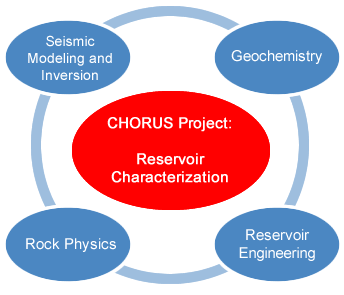CHORUS
The Consortium for Heavy Oil Research by University Scientists (CHORUS) project is an integrated reservoir characterization, reservoir simulation, seismic, rock physics, geochemistry oil industrial sponsored program located in the Geology, Geophysics and Petroleum Engineering Departments at the University of Calgary. Our research team consists of many outstanding scientists that deal with the real field cold production problems of today's heavy oil industry. Other collaborators include the U of C Geochemistry Research Team, the Petroleum and Chemical Engineering at the U of C that includes the heavy oil and oil sands reservoir modeling and simulation engineering special tem and Physics Department at the University of Alberta. While global energy consumption continues to rise and conventional oil reserves continue to diminish, more and more emphasis is being placed on maximizing production for heavy oil and bitumen reserves.
The correlation between seismic data and reservoir production data is very compelling. To better understand these correlations and the implications for enhanced oil recovery, we have directed our research efforts toward the integrated science studies of geochemical, geological, geology, reservoir production data, reservoir engineering and reservoir simulation. This research is leading toward a greater understanding of the various reservoir properties and should enhance the production from the heavy oil fields.
To-date, thermal recovery methods have been utilized to unlock both types of reserves. But with rising natural gas prices, producers are seeking alternative production methods that will minimize their operating costs. Cold production is the most cost effective production method already being utilized in Canada and is gaining ground as a viable means to produce heavy oil due to the use of progressing cavity pumps (PCP). These pumps act like augers and suck both sand and oil in to the well. With no natural gas required like thermal production methods, the biggest benefit of cold production is that it provides producers with energy savings.
Cold production is the most cost effective production method already being utilized in Canada and is gaining ground as a viable means to produce heavy oil due to the use of progressing cavity pumps (PCP). These pumps act like augers and suck both sand and oil in to the well. With no natural gas required like thermal production methods, the biggest benefit of cold production is that it provides producers with energy savings.
At the onset of cold production, the PCP's produce about 60 percent oil and 40 percent sand. Within about three months, these ratios improve to about 95 percent oil. These production improvements are attributed to the development of high porosity tubes known as "wormholes". These wormholes tend to spread horizontally creating a network of wells without having to use a drilling rig.
With cold production, after the heavy oil is brought to the surface by the PCPs, a settling tank then separates the oil and sand. Trucks would then routinely visit the production site to remove the produced oil and clean sand from the tanks. Members include both producers as well as service and supply companies that are all striving to develop more efficient cold production methods. The information gained through CHORUS research is not intellectual property and the results are shared and published in journals. All members pay an annual fee to be part of the group that is now entering its 7th year. CHORUS also provides a valuable research opportunity for world international visiting scholars to come and work within the CHORUS integrated science research team.
Numerical modelling of such complexity is of particular interest to the field operators. Ideal predictions can assist oil producers to not only design better pumping schemes for sand control, but also optimize oil production and ensure wellbore stability. In this paper, the authors present an integrated modular approach to quantitatively predict sand production and enhanced oil recovery. A modular approach is then adopted to effectively take advantage of the existing advanced standard reservoir and stress-strain codes. The model is implemented into three integrated computational modules, ie. erosion module, reservoir module, and geomechanics module. The stress, flow and erosion equations are solved separately for each time increment, and the coupling items (porosity, permeability, plastic shear strain, etc) are passed among them or iterated until convergence is achieved on a time step basis. Numerical results of field studies are presented to illustrate the capabilities of the model. The effects of foamy oil flow and sand production are also examined to demonstrate the impact on the enhanced hydrocarbon recovery. The model is ready to be used in conjunction with 4-D seismic to tune the erosion parameters and aid in the improvement of seismic interpretation.
Conclusions and Plans for Future Research
The real field data correlations between the seismic anomalies and the reservoir production data in the cold production fields is very compelling. To better understand these correlations and the implications for enhanced oil recovery we have directed our international heavy oil research efforts toward the heavy oil integrated science studies of geochemical, geological, geophysical and reservoir production data. CHORUS is working closely with our heavy oil industry international sponsors and is one of the leading research consortiums for cold production on the world stage. CHORUS presents / publishes some of our new and very important research results at our sponsor meetings, for private sponsor meetings and in magazines such as the SEG, CSEG, CGU, National Science Journal, SPE, EAGE and other leading international science journals.
New Developments at CHORUS
CHORUS is expanding its horizons in the reservoir characterization of SAGD in the Athabasca heavy oil fields. CHORUS is working with its sponsors to optimize both hot and cold production in heavy oil fields. more...
While CHORUS is a group that has focused on heavy oil, many of the CHORUS methods can be used in geophysical characterization of all unconventional reservoirs. more...